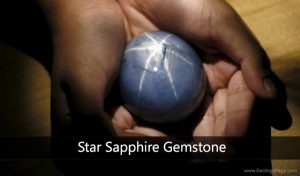
A star sapphire is a type of sapphire that exhibits a star-like phenomenon known as asterism; red stones are known as “star rubies”. Star sapphires contain intersecting needle-like inclusions following the underlying crystal structure that causes the appearance of a six-rayed “star”-shaped pattern when viewed with a single overhead light source.
The inclusion is often the mineral rutile, a mineral composed primarily of titanium dioxide. The stones are cut en cabochon, typically with the center of the star near the top of the dome. Occasionally, twelve-rayed stars are found, typically because two different sets of inclusions are found within the same stone, such as a combination of fine needles of rutile with small platelets of hematite; the first results in a whitish star and the second results in a golden-colored star.
During crystallisation, the two types of inclusions become preferentially oriented in different directions within the crystal, thereby forming two six-rayed stars that are superimposed upon each other to form a twelve-rayed star. Misshapen stars or 12-rayed stars may also form as a result of twinning. The inclusions can alternatively produce a “cat’s eye” effect if the ‘face-up’ direction of the cabochon’s dome is oriented perpendicular to the crystal’s c-axis rather than parallel to it. If the dome is oriented in between these two directions, an ‘off-center’ star will be visible, offset away from the high point of the dome.
Where Are They Found?
The most important deposits of fine star sapphire today are found in Australia, Myanmar (Burma), Sri Lanka and Thailand. Other significant star sapphire sources include Brazil, Cambodia, China, Kenya, Madagascar, Malawi, Nigeria, Pakistan, Rwanda, Tanzania, United States (Montana), Vietnam and Zimbabwe.
They are found dominantly in Sri Lanka, but also fine blue star sapphires have come from Burma. Black star sapphires have been found in Cambodia and India. Speaking of Burma, rubies also come from this famous source and we have this variety of corundum in our inventory as well.
The Star of Adam is the largest blue star sapphire which weighs 1404.49 carats. The gem was mined in the city of Ratnapura, southern Sri Lanka. The Black Star of Queensland, the largest gem-quality star sapphire in the world, weighs 733 carats. The Star of India (mined in Sri Lanka) (weighing 563.4 carats) is thought to be the second-largest star sapphire (the largest blue), and is currently on display at the American Museum of Natural History in New York City. The 182-carat Star of Bombay, (mined in Sri Lanka), located in the National Museum of Natural History, in Washington, D.C., is another example of a large blue star sapphire. The value of a star sapphire depends not only on the weight of the stone, but also the body color, visibility, and intensity of the asterism.
Star Sapphire Gemological Properties
| Chemical Formula | Al2O3 Aluminum oxide |
| Crystal Structure | (Trigonal) doubly pointy, barrel-shaped, hexagonal pyramids, tabloid-shaped |
| Color | Blue in various tones, pink, yellow, green, lavender, gray, black |
| Hardness | 9 on the Mohs scale |
| Refractive Index | 1.762 to 1.778 |
| Density | 3.95 to 4.03 |
| Cleavage | None |
| Transparency | Transparent, translucent, opaque |
| Double Refraction or Birefringence | -0.008 |
| Luster | Vitreous, silky |
| Fluorescence | Blue: none; colorless: orange-yellow, violet |
Star Sapphire Varieties
Besides for the varieties of Sapphire listed below, Sapphire with color other than blue are prefixed with their color names. The main gemstone colors in addition to blue Sapphire include:
- Yellow Sapphire (sometimes also called “Golden Sapphire” if intensely colored)
- Pink Sapphire
- White Sapphire (describes Sapphire that is colorless)
- Green Sapphire
- Purple Sapphire
- Orange Sapphire
- Black Sapphire
Star Sapphire Uses
Sapphire is one of the most popular gemstones, and is used extensively in Jewelry. Fine colored Sapphire with a deep blue color and excellent transparency can reach several thousand dollars a carat. The blue variety is most often used in jewelry, but the yellow, pink, and orange “fancies” have recently become very popular. Green and light blue Sapphires are also known, but are less commonly used in jewelry. Opaque Black Sapphire is also used a minor gemstone.
Sapphire is used in all forms of jewelry, including bracelets, necklaces, rings, and earrings. It is used both as centerpiece gemstone in pendants and rings, as well as a secondary stone to complement other gemstones such as Diamonds. Star Sapphires are polished as cabochons, and, if clear, are extremely valuable.
The rare orange-pink variety, known as Padparadschah, can be even more valuable than fine blue Sapphire. Blue Sapphire is sometimes carved into cameos or small figures, especially the less transparent material. Synthetic Sapphire is often used as a cheap substitute for the natural material.
Reference:
Wikipedia: Sapphire
Minerals: The Precious Gemstone Sapphire
The Natural Sapphire Company: Star Sapphires










